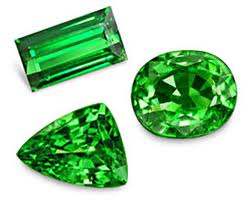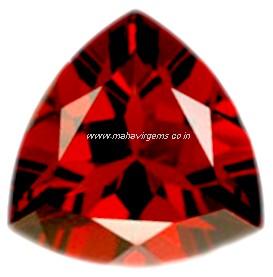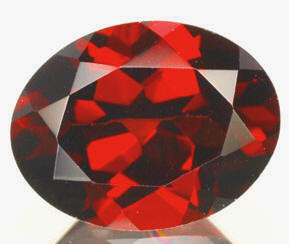








Copyright 2009-2014 Mahavir Gems. All Rights Reserved.
MAHAVIR GEMS

This site is best viewed on 1024 x 768 screen resolution using Mozilla 3.5 Browser
Garnet is derived from the Latin word "granum" meaning "grain".
"GRANUM" refers to the typically rounded shape of Garnet and also reminiscent of the seeds of the pomegranate.
Garnets have been widely known for thousands of years. Even Noah, it is reported, used a lantern from garnet in order to safely steer his Ark through the darkness of the night.
Although the color red occurs most frequently, there are also garnets showing different shades of green, pale to bright yellow, blue, blue-green, fiery orange and fine earth- and umbra-shades.
The excellent hardness of 7 to 7.5 on the Mohs' scale explains, why these gemstones are so excellent to wear. Garnets are quite sturdy and resistant to everyday wear and tear, and uncomplicated to work into jewelry.
Garnet is the birthstone for the month of January.
Garnet colors
Although the color red is occurs most frequently, there are also garnets showing different shades of green, pale to bright yellow, fiery orange and fine earth- and umbra-shades. Blue is the only color that is not available in Garnet. Color change garnets are mostly pyrope and spessartite in composition.
The colorful members of the garnet group:
- Pyrope, red garnet, frequently with brown tint
- Rhodolite, purplish red or rose-color garnet
- Almandite, red garnet with violet tint
- Spessartite, orange to red-brown garnet. The best specimen comes from Namibia and is called "Mandarin Spessartine".
- Grossularite, colorless, green, yellow, brown garnet
- Hydrogrossular, dense, opaque greenish variety of grossularite
- Hessonite (Gomedhak ), brown-red variety of garnet
- Leuco garnet, colorless variety of grossularite
- Tsavorite, green to emerald green garnet
- Andradite, black, brown, yellow-brown garnet
- Demantoid, the most valuable garnet, green to emerald green
- Melanite, opaque black variety of andradite
- Tapazolite, yellow to lemon yellow, topaz-like variety of andradite
- Uvarovite, emerald green garnet that rarely occurs in gemstone quality.
Pyrope Mg3Al2Si3O12
Pyrope gets its name from its coloration: the Greek word "pyro" means fire. This is one of the most common forms of garnet. Its colour is commonly deep red to black. It forms a rounded, transparent crystal, which, together with its deep red color, makes it a most desirable gem. Some pyrope contains thread-like inclusions which often taper at the ends. Other pyrope garnets can be transparent. Pyrope occurs together with diamonds in Kimberlite pipes (volcanic pipes), and can also be found as rounded, waterworn pebbles in placer deposits (an area in a stream or river where heavy material settles after being carried downstream by the current)
~~~~~~~~~~~~~~~~~~~~~~~~~~~~~~~~~~~~~~~~~~~~~~~~~~~~~~~
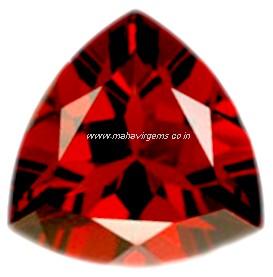
RHODOLITE: purplish red or rose-color garnet
Rhodolite is the name used to describe the lovely pinkish, purplish or lavender Red Garnets which are a mixture of Almandite and Pyrope. This name was first used in the late 1800's to describe the new rhododendron shade of Garnets discovered in North Carolina.
Rhodolite Garnets are not as dark as the common Pyrope Garnets. Rhodolites are normally African in origin and are bright, transparent Gems. Rhodolites are usually Red stones, purplish Red and the popular Raspberry Rhodolite, rich Purple with bright Lavender highlights. Prices are based on the color, size and clarity of the stone.
~~~~~~~~~~~~~~~~~~~~~~~~~~~~~~~~~~~~~~~~~~~~~~~~~~~~~

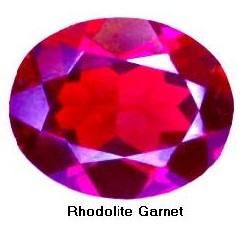
Almandine Fe3Al2Si3O12
Almandine, also known incorrectly as almandite,
The name almandite has evolved from the name of an Anotolian city named Alabanda( in Turkey, Asia Minor). Almandite can range in colour from deep red to reddish-brown, sometimes with a violet or brown hue and and it can sometimes have a star-shaped inclusion. The iron in this garnet is frequently replaced to some extent by magnesium and manganese. Although very common, almandine seldom occurs in specimens worthy of gemstone collections. Nethertheless, some almandite was used in early Victorian jewellery.
In the trade, gem dealers hardly ever refer to their stock as "pyrope" or "almandite". Instead, they will often refer to "brown" or Indian garnets.
~~~~~~~~~~~~~~~~~~~~~~~~~~~~~~~~~~~~~~~~~~~~~~~~~~~~~
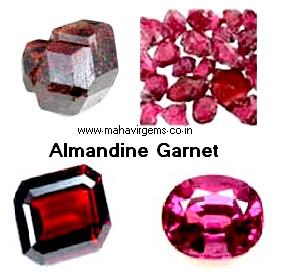
Spessartine Mn3Al2Si3O12.
The best specimen comes from Namibia and is called "Mandarin Spessartine".
Spessatite is named for the area of Bavaria in which it is mined: Spessart. Spessartine is not as common as most other garnets. It occurs in Iskardu, Pakistan; Sri Lanka; Sanyeshan, Guangdon Province in China; Broken Hill in New South Wales, Australia; and Berilanda, Ceara, Brazil. The manganese is often replaced by some magnesium and iron. Spessatite ranges in colour from brownish red - caused by iron impurities - to (in some cases) orange. This particular type of garnet is one of the more expensive.
~~~~~~~~~~~~~~~~~~~~~~~~~~~~~~~~~~~~~~~~~~~~~~~~~~~~~
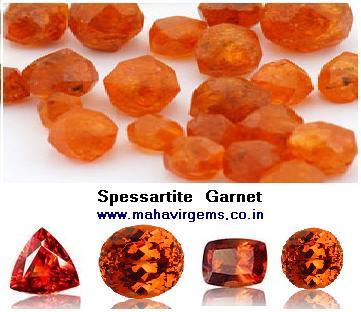
Grossular Ca3Al2Si3O12
The name grossular comes from the Greek word for gooseberry "grossularia". Grossular is the most varicolored of all garnets. It occurs in all shades of colour except blue. It most often occurs in crystal groups on a matrix, although single crystals and rounded, waterworn pebbles have also been found. Most cut grossular gems are known simply as "Garnets"or "Grossular Garnet", except for Hessonite, which is known by its own name in the gem market. Hessonite is a form of grossular garnet that ranges in colour from deep yellow to brown, and it is is the most famous type of this garnet. Tsavolite or Tsavorite is another form of grossular that comes in shades of green mainly because of its chromium and vanadium composition. It is named after the Tsavo National Park in Tanzania, Africa where it can be found. Other grossular garnets include Leuco, Rosolite, Raspberry, Gooseberry, and Imperial. There even exist grossular garnets that resemble jade and come in a variety of green and multicolored shades. These garnets, known as African jades, have been used in tribal carvings and statue fashioning.
~~~~~~~~~~~~~~~~~~~~~~~~~~~~~~~~~~~~~~~~~~~~~~~~~~~~~
Uvarovite Ca3Cr2Si3O12
Uvarovite is emerald-green. It is named after the Russian noble Sergei Uvarov. Uvarovite is a rare mineral, and its occurrences are limited. The largest crystals of this mineral come from Outukumpu, Finland. Uvarovite also can be found in Val Malenco, Lombardy, Italy; Sarany (in the Ural Mountains), Russia; and in the Kop Krom mine, Erzerum, Turkey. Uvarovite is the only garnet not made into a gemstone, because it almost never occurs in crystals large enough to be faceted. However, it is quite valuable to collectors, for its colour and rarity make it special.
~~~~~~~~~~~~~~~~~~~~~~~~~~~~~~~~~~~~~~~~~~~~~~~~~~~~~
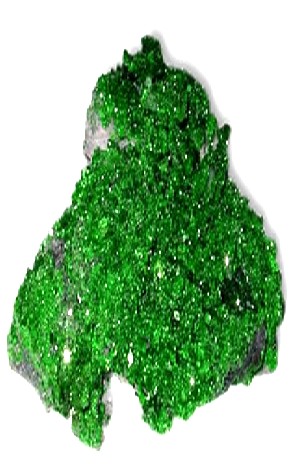
Andradite Ca3Fe2Si3O12
Andradite has the most powerful luster of any garnet, and this makes it a reputable gem. Its name comes from the name of a mineralogist from Brazil named J.B D'Andrada. The yellow, orange, and brown varieties of andradite are all faceted. Some transparent andradites are described as demantoid, or diamond-like, because of their prismatic abilities and similarity in appearance to diamonds, though andradites are yellow, green or brown. Demantoids are found in a variety of places but the principal and most important deposit is along the Bobravka River in the Ural Mountains of Russia. After this famous deposit was discovered in 1868 demantoids soon became a favourite gem of the Russian Tsars. The green demantoid variety is the main gem form of this garnet, and is the most valuable of all garnets. Other andradites include Topazolite, and Melanite. The opaque, black Melanite variety is sometimes worn as mourning jewellery.
~~~~~~~~~~~~~~~~~~~~~~~~~~~~~~~~~~~~~~~~~~~~~~~~~~~~~
